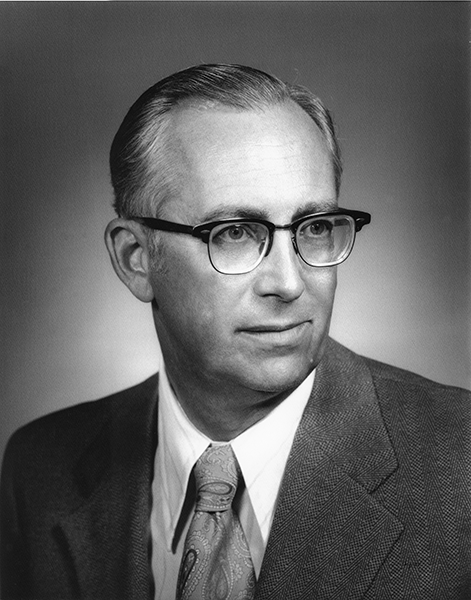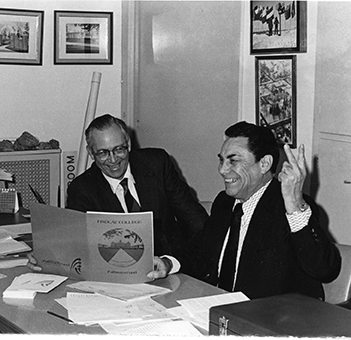 When he became president of Findlay College, Glen R. Rasmussen had an extensive background in higher education. After he earned his undergraduate degree in music and a master's in music education at Wayne State University, he served as assistant professor and director of instrumental music at Georgia Southern College in Statesboro, Georgia from 1948 to 1950. He lectured in psychology at Eastern Michigan University, Ypsilanti, Michigan, before earning his Ph.D. in educational psychology in 1953 and served as a lecturer at U of M. In 1956, Rasmussen was the first professor hired by the University of Michigan for their new Flint campus where, as associate professor of educational psychology, he helped to formulate the new college's academic program. After a year as professor of psychology and education at Southern Illinois University, he was named vice-president and academic dean and professor of psychology at Carthage College in Kenosha, Wisconsin, in 1963. In 1968, he moved to Morningside College, Sioux City, Iowa, where he served as vice-president for academic affairs and professor of psychology until moving to Findlay on March I, 1972. In addition to his teaching and administrative experience, Rasmussen was widely published and delivered more than 300 lectures on psychology and education during his career.
When he became president of Findlay College, Glen R. Rasmussen had an extensive background in higher education. After he earned his undergraduate degree in music and a master's in music education at Wayne State University, he served as assistant professor and director of instrumental music at Georgia Southern College in Statesboro, Georgia from 1948 to 1950. He lectured in psychology at Eastern Michigan University, Ypsilanti, Michigan, before earning his Ph.D. in educational psychology in 1953 and served as a lecturer at U of M. In 1956, Rasmussen was the first professor hired by the University of Michigan for their new Flint campus where, as associate professor of educational psychology, he helped to formulate the new college's academic program. After a year as professor of psychology and education at Southern Illinois University, he was named vice-president and academic dean and professor of psychology at Carthage College in Kenosha, Wisconsin, in 1963. In 1968, he moved to Morningside College, Sioux City, Iowa, where he served as vice-president for academic affairs and professor of psychology until moving to Findlay on March I, 1972. In addition to his teaching and administrative experience, Rasmussen was widely published and delivered more than 300 lectures on psychology and education during his career.
Rasmussen overcame enrollment concerns in the early 1970s through new procedures and programs that devoted additional resources to recruitment, and the College registered surpluses from 1977-1978 through the centennial year. Employing a genial, low-keyed and reasoning style of leadership, President Rasmussen worked steadily with the faculty, staff, Board of Trustees and community in exploring ways to locate and meet educational needs within the framework of a liberal arts program. Along with Robert Crosby and Sam Richmond from institutional advancement, he led the Pathways fundraising campaign in 1973, which raised more than $1.4 million in gifts and pledges and later $945,000 more through the Centennial Challenge Fund. The funds supported the offices of Community Education, Career Counseling, Student Information and Recruitment; and scholarships, student facilities renovation and faculty development.
Changes to the College's academic programs in Rasmussen's time included the introduction of the freshman seminar, courses in public administration, the western equestrian studies program and the welcoming of the first class of international students enrolled in the Intensive English Language Institute in 1975. Rasmussen also developed a long-range planning committee comprised of administrators, faculty, students, trustees and a community representative. The committee discussed educational philosophy, investigated current trends in higher education, reviewed proposed calendar and curriculum changes and later developed a goals/mission statement for the institution.
As president of Findlay College, Rasmussen served on the board of directors for the Association of Independent Colleges and Universities in Ohio, and the Ohio Foundation of Independent Colleges. Locally, he was a trustee of the United Way, a director of the Findlay Area Chamber of Commerce and a member of Rotary and Torch Clubs, Findlay Symposium and the First Lutheran Church. He was the first president who was not also a member of the Churches of God. Rasmussen, a clarinetist and flutist, was active in music throughout his career, including the Wayne University Concert Band, the U.S. Army Band (340th AGF) and as the director of church choirs. While president of Findlay College, he frequently played the clarinet and flute during informal musical get-togethers on campus. His hobbies also included golf and tennis. He and his wife Joyce had five children, two of whom graduated from Findlay College. He retired his role as president in 1982 and moved to North Carolina. At commencement on May 9, 1983, he was recognized for his service with an honorary Doctor of Humane Letters.

President Rasmussen with distinguished alumnus Tennyson Guyer.